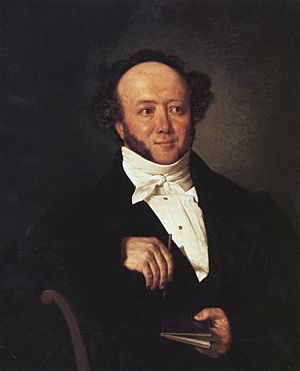Jeremias Gotthelf facts for kids
Albert Bitzius (October 4, 1797 – October 22, 1854) was a Swiss writer and pastor. He is much better known by his pen name, Jeremias Gotthelf. He was born in Murten, a town in Switzerland. His father was a pastor there.
Contents
Early Life and Education
In 1804, when Albert was seven years old, his family moved to Utzenstorf. This village is in the Bernese Emmental region. Albert grew up there and started his education. He also helped his father work on their land.
In 1812, he went to Bern to finish his studies. By 1820, he became a pastor. He visited the University of Göttingen in 1821. However, he returned home in 1822 to help his father as an assistant pastor.
Becoming a Pastor and Writer
When his father passed away in 1824, Albert became a priest in Herzogenbuchsee. In 1829, he moved to Bern. Then, in 1831, he went to help the old pastor in the village of Lützelflüh. This village is in the Upper Emmenthal area. In 1832, he was chosen to take over as the main pastor there. He married one of the old pastor's granddaughters in 1833. He lived the rest of his life in Lützelflüh. He had three children. His son also became a pastor, and his two daughters married pastors.
His First Book
His first book, Bauernspiegel (which means The Peasant's Mirror), came out in 1837. This book pretended to be the life story of Jeremias Gotthelf, told by himself. Albert Bitzius later used this name as his own writing name.
The book painted a clear picture of village life in the Bernese Emmenthal. It showed things as they really were, not trying to hide any problems. The book was written in German, but it included some words from the local Bernese dialect. Unlike some other writers, Albert Bitzius was not born a farmer. He came from an educated family. He wrote about what he had seen and learned, not what he had personally experienced as a farmer. The book was very popular because it showed real life, not just made-up stories about villagers.
Famous Stories
His most famous book is Die Schwarze Spinne (The Black Spider). This is a short novel that tells a story about the plague. The plague appears as a scary monster, a black spider, that destroys a Swiss village. The story is partly a symbolic tale. It shows how bad things can happen when people make deals with the devil out of need. It also shows how moral problems can make the monster return.
Other important stories he wrote include:
- Leiden und Freuden eines Schulmeisters (1838-1839) – Sorrows and Joys of a Schoolmaster
- Uli der Knecht (1841) – Uli the Farmhand
- Uli der Pächter (1849) – Uli the Tenant (a follow-up to Uli der Knecht)
- Anne-Bäbi Jowäger (1843-1844)
- Käthi, die Großmutter (1846) – Käthi, the Grandmother
- Die Käserei in der Vehfreude (1850) – The Cheese Dairy in Vehfreude
- Erlebnisse eines Schuldenbauers (1853) – Experiences of a Debt-Ridden Farmer
He also published several collections of shorter stories.
Later Years and Legacy
Albert Bitzius sometimes included local political ideas in his writings. He was a Whig, which was a political group at the time. He did not agree with the Radical party, which became strong in his canton in 1846.
He passed away on October 22, 1854, in Lützelflüh in the Canton of Bern. His works are still studied and enjoyed today, giving us a look into Swiss village life in the 1800s.

See also
 In Spanish: Jeremias Gotthelf para niños
In Spanish: Jeremias Gotthelf para niños


